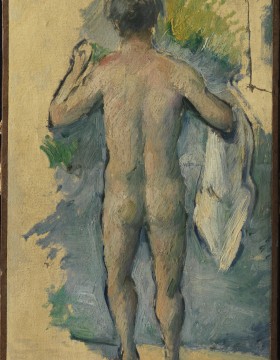Standing Bather Seen from Behind (Baigneur Debout Vu de Dos)
Standing Bather Seen from Behind (Baigneur Debout Vu de Dos)

About This Work
Provenance
Louis Bernard, Paris; [sold to Galerie Bernheim-Jeune, Paris, 28 Sept. 1910]; sold to Jos Hessel (1859–1942), Paris, 11 Nov. 1910. [Galerie Bignou, Paris, after 1929]. [possibly Alexander Reid & Lefevre, Ltd., London, by June 1939]. [Bignou Gallery, New York, by October 1940]. [Dalzell Hatfield, Los Angeles]. [Fine Arts Associates, New York, by 1955]; sold to Henry Pearlman’s daughter Marjorie Scheuer, New York, by 23 Sept. 1955, possibly acting on behalf of her father; Henry Pearlman, by 1959; Henry and Rose Pearlman Foundation, 1981.
Conservator's Note
The artist first used a black crayon-like instrument, perhaps a lithographic crayon, to sketch in a clear outline of the figure; he then applied thinned oils within the border defined by the black outline.
Critical Perspective
Cézanne made more than two hundred paintings, drawings, lithographs, and watercolors of bathing figures. This is a study, cut from a larger canvas that probably contained other studies, and it appears to have supplied the pose for a figure in a painting now in Detroit. Cézanne’s childhood friend, the author Émile Zola, described two young people swimming in a river in his novel La Fortune des Rougon (1871), an episode that seems based on memories of the boys’ swimming expeditions. Joachim Gasquet, who became Cézanne’s confidant in 1895, described the bathing parties as "their supreme joy," lasting from morning to evening, so that the youths were saturated with the landscape and "the countryside became part of them."
